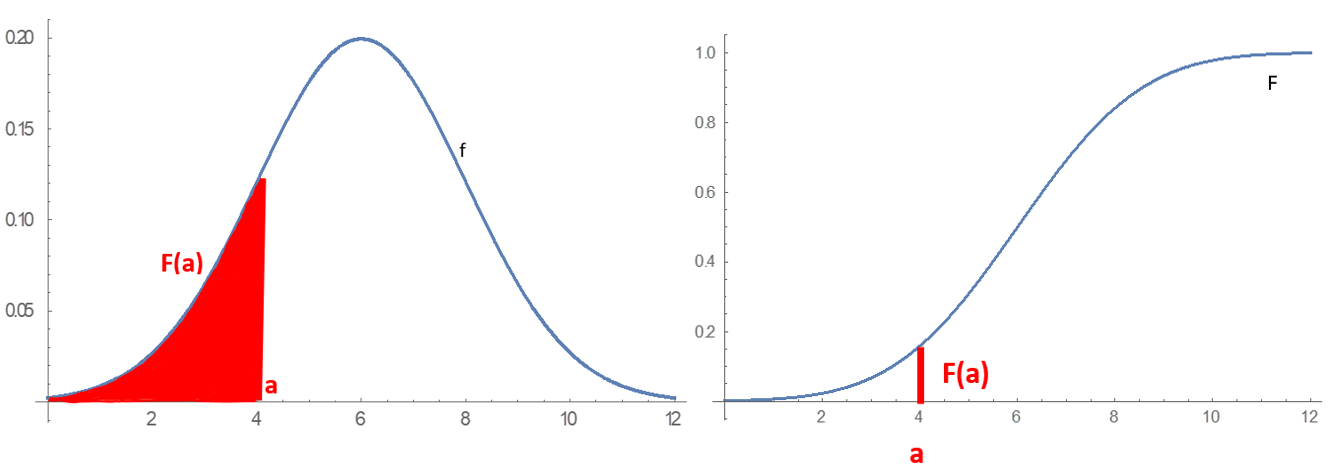|
Poisson Random Measure
Let (E, \mathcal A, \mu) be some measure space with \sigma- finite measure \mu. The Poisson random measure with intensity measure \mu is a family of random variables \_ defined on some probability space (\Omega, \mathcal F, \mathrm) such that i) \forall A\in\mathcal,\quad N_A is a Poisson random variable with rate \mu(A). ii) If sets A_1,A_2,\ldots,A_n\in\mathcal don't intersect then the corresponding random variables from i) are mutually independent. iii) \forall\omega\in\Omega\;N_(\omega) is a measure on (E, \mathcal ) Existence If \mu\equiv 0 then N\equiv 0 satisfies the conditions i)–iii). Otherwise, in the case of finite measure \mu, given Z, a Poisson random variable with rate \mu(E), and X_, X_,\ldots, mutually independent random variables with distribution \frac, define N_(\omega) = \sum\limits_^ \delta_(\cdot) where \delta_(A) is a degenerate measure located in c. Then N will be a Poisson random measure. In the case \mu is not finite the measure N can be obtained ... [...More Info...] [...Related Items...] OR: [Wikipedia] [Google] [Baidu] |
Measure Space
A measure space is a basic object of measure theory, a branch of mathematics that studies generalized notions of volumes. It contains an underlying set, the subsets of this set that are feasible for measuring (the -algebra) and the method that is used for measuring (the measure). One important example of a measure space is a probability space. A measurable space consists of the first two components without a specific measure. Definition A measure space is a triple (X, \mathcal A, \mu), where * X is a set * \mathcal A is a -algebra on the set X * \mu is a measure on (X, \mathcal) In other words, a measure space consists of a measurable space (X, \mathcal) together with a measure on it. Example Set X = \. The \sigma-algebra on finite sets such as the one above is usually the power set, which is the set of all subsets (of a given set) and is denoted by \wp(\cdot). Sticking with this convention, we set \mathcal = \wp(X) In this simple case, the power set can be writ ... [...More Info...] [...Related Items...] OR: [Wikipedia] [Google] [Baidu] |
Probability Distribution
In probability theory and statistics, a probability distribution is a Function (mathematics), function that gives the probabilities of occurrence of possible events for an Experiment (probability theory), experiment. It is a mathematical description of a Randomness, random phenomenon in terms of its sample space and the Probability, probabilities of Event (probability theory), events (subsets of the sample space). For instance, if is used to denote the outcome of a coin toss ("the experiment"), then the probability distribution of would take the value 0.5 (1 in 2 or 1/2) for , and 0.5 for (assuming that fair coin, the coin is fair). More commonly, probability distributions are used to compare the relative occurrence of many different random values. Probability distributions can be defined in different ways and for discrete or for continuous variables. Distributions with special properties or for especially important applications are given specific names. Introduction A prob ... [...More Info...] [...Related Items...] OR: [Wikipedia] [Google] [Baidu] |
Poisson-type Random Measures
Poisson-type random measures are a family of three random counting measures which are closed under restriction to a subspace, i.e. closed under thinning. They are the only distributions in the canonical non-negative power series family of distributions to possess this property and include the Poisson distribution, negative binomial distribution, and binomial distribution. The PT family of distributions is also known as the Katz family of distributions, the Panjer or (a,b,0) class of distributions and may be retrieved through the Conway–Maxwell–Poisson distribution. Throwing stones Let K be a non-negative integer-valued random variable K\in\mathbb_=\mathbb_\cup\) with law \kappa, mean c\in(0,\infty) and when it exists variance \delta^2>0. Let \nu be a probability measure on the measurable space (E,\mathcal). Let \mathbf=\ be a collection of iid random variables (stones) taking values in (E,\mathcal) with law \nu. The random counting measure N on (E,\mathcal) depends on the pa ... [...More Info...] [...Related Items...] OR: [Wikipedia] [Google] [Baidu] |
Lévy Process
In probability theory, a Lévy process, named after the French mathematician Paul Lévy, is a stochastic process with independent, stationary increments: it represents the motion of a point whose successive displacements are random, in which displacements in pairwise disjoint time intervals are independent, and displacements in different time intervals of the same length have identical probability distributions. A Lévy process may thus be viewed as the continuous-time analog of a random walk. The most well known examples of Lévy processes are the Wiener process, often called the Brownian motion process, and the Poisson process. Further important examples include the Gamma process, the Pascal process, and the Meixner process. Aside from Brownian motion with drift, all other proper (that is, not deterministic) Lévy processes have discontinuous paths. All Lévy processes are additive processes. Mathematical definition A Lévy process is a stochastic process X=\ that satisfi ... [...More Info...] [...Related Items...] OR: [Wikipedia] [Google] [Baidu] |
Stochastic Process
In probability theory and related fields, a stochastic () or random process is a mathematical object usually defined as a family of random variables in a probability space, where the index of the family often has the interpretation of time. Stochastic processes are widely used as mathematical models of systems and phenomena that appear to vary in a random manner. Examples include the growth of a bacterial population, an electrical current fluctuating due to thermal noise, or the movement of a gas molecule. Stochastic processes have applications in many disciplines such as biology, chemistry, ecology Ecology () is the natural science of the relationships among living organisms and their Natural environment, environment. Ecology considers organisms at the individual, population, community (ecology), community, ecosystem, and biosphere lev ..., neuroscience, physics, image processing, signal processing, stochastic control, control theory, information theory, computer scien ... [...More Info...] [...Related Items...] OR: [Wikipedia] [Google] [Baidu] |
Random Measure
In probability theory, a random measure is a measure-valued random element. Random measures are for example used in the theory of random processes, where they form many important point processes such as Poisson point processes and Cox processes. Definition Random measures can be defined as transition kernels or as random elements. Both definitions are equivalent. For the definitions, let E be a separable complete metric space and let \mathcal E be its Borel \sigma -algebra. (The most common example of a separable complete metric space is \R^n .) As a transition kernel A random measure \zeta is a ( a.s.) locally finite transition kernel from an abstract probability space (\Omega, \mathcal A, P) to (E, \mathcal E) . Being a transition kernel means that *For any fixed B \in \mathcal \mathcal E , the mapping : \omega \mapsto \zeta(\omega,B) :is measurable from (\Omega, \mathcal A) to (\R, \mathcal B(\R)) *For every fixed \omega \in \Omega , the mapping : B ... [...More Info...] [...Related Items...] OR: [Wikipedia] [Google] [Baidu] |
Degenerate Distribution
In probability theory, a degenerate distribution on a measure space (E, \mathcal, \mu) is a probability distribution whose support is a null set with respect to \mu. For instance, in the -dimensional space endowed with the Lebesgue measure, any distribution concentrated on a -dimensional subspace with is a degenerate distribution on . This is essentially the same notion as a singular probability measure, but the term ''degenerate'' is typically used when the distribution arises as a limit of (non-degenerate) distributions. When the support of a degenerate distribution consists of a single point , this distribution is a Dirac measure in : it is the distribution of a deterministic random variable equal to with probability 1. This is a special case of a discrete distribution; its probability mass function equals 1 in and 0 everywhere else. In the case of a real-valued random variable, the cumulative distribution function of the degenerate distribution localized in is ... [...More Info...] [...Related Items...] OR: [Wikipedia] [Google] [Baidu] |
Random Variable
A random variable (also called random quantity, aleatory variable, or stochastic variable) is a Mathematics, mathematical formalization of a quantity or object which depends on randomness, random events. The term 'random variable' in its mathematical definition refers to neither randomness nor variability but instead is a mathematical function (mathematics), function in which * the Domain of a function, domain is the set of possible Outcome (probability), outcomes in a sample space (e.g. the set \ which are the possible upper sides of a flipped coin heads H or tails T as the result from tossing a coin); and * the Range of a function, range is a measurable space (e.g. corresponding to the domain above, the range might be the set \ if say heads H mapped to -1 and T mapped to 1). Typically, the range of a random variable is a subset of the Real number, real numbers. Informally, randomness typically represents some fundamental element of chance, such as in the roll of a dice, d ... [...More Info...] [...Related Items...] OR: [Wikipedia] [Google] [Baidu] |
Sigma Finite Measure
Sigma ( ; uppercase Σ, lowercase σ, lowercase in word-final position ς; ) is the eighteenth letter of the Greek alphabet. In the system of Greek numerals, it has a value of 200. In general mathematics, uppercase Σ is used as an operator for summation. When used at the end of a letter-case word (one that does not use all caps), the final form (ς) is used. In ' (Odysseus), for example, the two lowercase sigmas (σ) in the center of the name are distinct from the word-final sigma (ς) at the end. The Latin letter S derives from sigma while the Cyrillic letter Es derives from a lunate form of this letter. History The shape (Σς) and alphabetic position of sigma is derived from the Phoenician letter ( ''shin''). Sigma's original name may have been ''san'', but due to the complicated early history of the Greek epichoric alphabets, ''san'' came to be identified as a separate letter in the Greek alphabet, represented as Ϻ. Herodotus reports that "san" was the name gi ... [...More Info...] [...Related Items...] OR: [Wikipedia] [Google] [Baidu] |
Finite Measure
In measure theory, a branch of mathematics, a finite measure or totally finite measure is a special measure that always takes on finite values. Among finite measures are probability measures. The finite measures are often easier to handle than more general measures and show a variety of different properties depending on the sets they are defined on. Definition A measure \mu on measurable space (X, \mathcal A) is called a finite measure if it satisfies : \mu(X) < \infty. By the monotonicity of measures, this implies : If is a finite measure, the is called a finite measure space or a totally finite measure space. Properties General case For any ...[...More Info...] [...Related Items...] OR: [Wikipedia] [Google] [Baidu] |
Statistical Independence
Independence is a fundamental notion in probability theory, as in statistics and the theory of stochastic processes. Two events are independent, statistically independent, or stochastically independent if, informally speaking, the occurrence of one does not affect the probability of occurrence of the other or, equivalently, does not affect the odds. Similarly, two random variables are independent if the realization of one does not affect the probability distribution of the other. When dealing with collections of more than two events, two notions of independence need to be distinguished. The events are called pairwise independent if any two events in the collection are independent of each other, while mutual independence (or collective independence) of events means, informally speaking, that each event is independent of any combination of other events in the collection. A similar notion exists for collections of random variables. Mutual independence implies pairwise independence ... [...More Info...] [...Related Items...] OR: [Wikipedia] [Google] [Baidu] |


